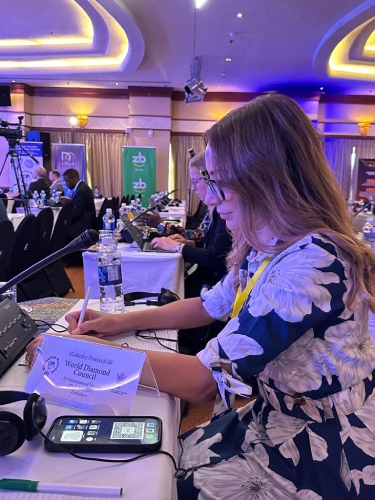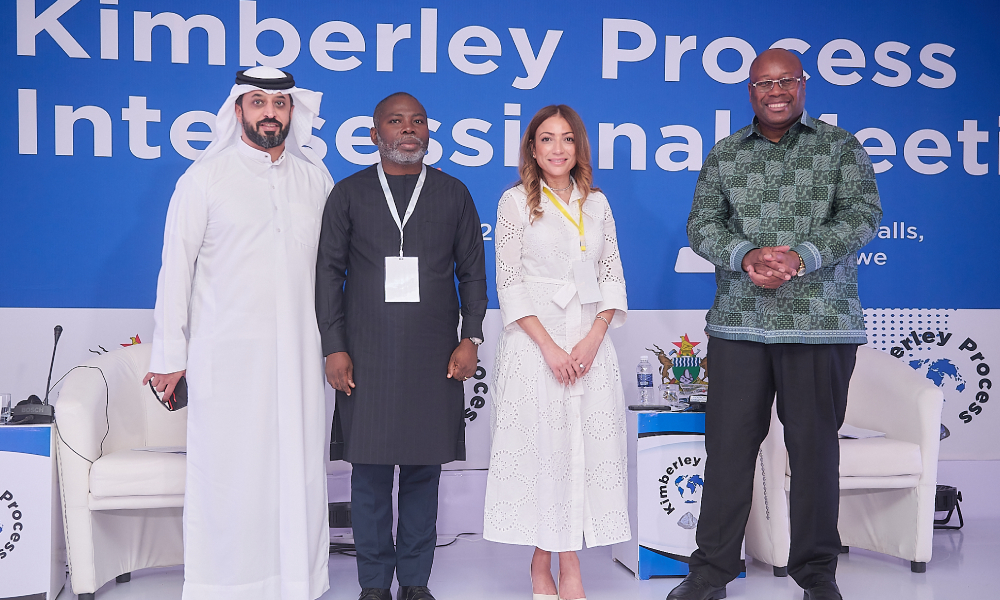Solitaire brings you exclusive insights from FERIEL ZEROUKI, the President of the World Diamond Council (WDC), to discuss her remarkable journey in the diamond industry and her vision for promoting responsible practices, enhancing traceability, and driving progress within the industry. Her leadership aims to safeguard the integrity of the natural diamond value chain and pave the way for a thriving and ethically-driven future in the global market.
Can you share with our readers your journey in the diamond industry and your experience leading up to your current position as the President of the World Diamond Council?
I joined the industry in 2005 when I was hired by De Beers Group in London. As mathematics graduate, I signed on initially as a supply chain analyst.
I was part of a new generation of hires at De Beers which was quite diverse in terms of background and gender. Among my responsibilities was producing three-year forecasts in support of the business’s Supplier of Choice Sightholder contracts. I introduced new modelling techniques that helped improve our forecast accuracy by as much as 20 percent.
Two years in, and I was promoted to being a more general business analyst, spending a year gaining invaluable insight into De Beers’ internal supply chain. Then in 2008, I began a journey that was to shape my career, when was I transferred to the group’s Responsible Business Initiatives unit. There, I led the development and launch of the SMART System, which is an online tool that facilitates the group’s Best Practice Principles Assurance Program, as well as screening of suppliers and Sightholders, making certain that they meet the highest ethical standards.
In 2010 I was named Best Practice Principles (BPP) Manager, administering the standards that are a contractual requirement for all De Beers Sightholders, playing a central role with regards to the way in which the group conducts its business activities. It’s a position I held for five years and it exposed me to important policy work.
This made the transition into my next role in 2015, as Head of Government and Industry Relations at De Beers, seamless. In this role I was charged with engaging with key stakeholders around the world, including governments, industry and civil society. It was during this period that I became a member of the Board of Directors of the World Diamond Council, and also a Board member of the Responsible Jewellery Council, where I today serve as Treasurer.
In February 2018 I was appointed Senior Vice President of International Relations and Ethical Initiatives at De Beers, overseeing De Beers’ engagement strategy with multi-lateral institutions, governments and industry, with the goal of advancing the group’s strategic interests, as well as all responsible business initiatives, including the BPP and other ethical pipeline compliance programs.
It was at this time that I worked on the launch of Tracr and establishment of GemFair, serving as its General Manager. GemFair is an initiative launched by De Beers in Sierra Leone to support the formalisation of the artisanal mining sector in Sierra Leone whilst securing a route to market through digital innovation and providing fair value for their goods.
Since October 2020 I have been Senior Vice President, Corporate Affairs of De Beers Group, in charge of internal and external communications, corporate brand positioning, ethical and sustainable value chains, international relations, trade engagement, and also GemFair. My mission is to support the group’s commercial objectives, while protecting the integrity of our product, supply chain and corporate brand.
I became President of the World Diamond Council in March of this year, after serving as its Vice President for three years. It’s been quite a journey!

As the new President of the World Diamond Council, what are your key priorities and goals for the organisation? How do you plan to enhance standards and drive progress within the diamond industry?
The WDC’s mission is to safeguard the integrity of the natural diamond value chain, and in so doing protect the aspirational value of our remarkable product, while providing security and fair opportunity to all responsible members of the industry and our stakeholders.
That is the broad vision, but to achieve it we need to be effective in a number of arenas. First and foremost is the Kimberley Process, where we represent the industry’s interests, in a forum that includes representatives of government and civil society.
The KP’s remit is eliminating the trade of conflict diamonds from the rough diamond supply chain. This is complemented by the WDC’s System of Warranties (SoW) which was launched at the inception of the KP and covers all natural diamonds – rough and polished – from the mine to the retail jeweller. In 2018 WDC evolved the SoW to cover a broader, more relevant set of criteria, addressing a more expansive range of ethical challenges, from human and labour rights through to anti-money laundering and corruption.
The WDC is not an exclusive club, but very much a grass-roots organisation. Our authority to speak on behalf of the industry is vested in the fact the key associations, who collectively represent literally hundreds of thousands of members, are represented in both our ranks and leadership. They are joined by leading commercial organisations, like De Beers, Chow Tai Fook, Tiffany & Co and Signet. Our ability to act decisively requires that we do so together – applying standards of behaviour and implementing programs – like the revised System of Warranties – that collectively enhance the integrity of the supply chain.
The same applies to the Kimberley Process Certification Scheme. This element of co-dependency is a message that I stressed the very first time I addressed the KP as WDC President. I called on its members to reject polarisation, emphasising that there is more that unites us than divides us. Today, there are two cardinal principles we all must respect. The first is that natural diamonds will optimise their economic viability only if they remain a product that end clients aspire to buy. And, for that to occur, the second cardinal principle must be applied, which is that natural diamonds must meet their potential as a catalyst for sustainable development and wellbeing, particularly in the countries where they are mined and processed.
Simply put, the value of a diamond depends on the values it represents.
The diamond industry has faced numerous challenges in recent years, including ethical concerns and environmental sustainability. How do you plan to address these issues and ensure that the industry operates with integrity and responsibility?
First, it’s important to note that these are global challenges not unique to the diamond industry. What’s important is for the industry to effectively develop sustainable commercial approaches that also deliver solutions to these important global challenges. As an industry organisation, our role is to develop such systems and strategies that are both effective and accessible to all players large and small. We don’t do this in a vacuum, but through partnerships and collaboration.
Our job can be particularly challenging, especially in the Kimberley Process, where we hold Observer status. Only government Participants have veto powers, and any decision by them requires full consensus.
That said, the level of integrity and responsibility in any supply chain always comes down to the actions of individual companies and actors. If each applies the standards and principles that are already established – including the Kimberley Process Certification Scheme, the WDC System of Warranties, the Responsible Jewellery Council’s Code of Practice, and others – and at the same monitors the actions of its own suppliers, then I firmly believe that we are able to assert that the natural diamonds we trade in have been sourced, processed and handled responsibly and ethically.

The Kimberley Process Certification Scheme plays a crucial role in ensuring that diamonds are conflict-free. What specific measures do you believe should be implemented to strengthen the KP and its effectiveness in today’s evolving landscape?
There are a number of measures that should be taken, or already have been.
Undoubtedly, the most fundamentally important measure involves the expansion of the definition of “conflict diamonds” in the KP Core Document, which is something that the WDC has advocated for many years already. The current definition, which describes conflict diamonds as rough goods whose revenues are being used to finance civil wars against legitimate governments, was appropriate when the KPCS was launched in 2003, but currently does not cover all instances that we believe reasonably should be considered.
Right now, the KP is undergoing a periodic Review and Reform Cycle, where the conflict diamond definition is once again on the agenda. The sub-group leading that discussion is chaired by the WDC, and there currently is a generally positive feeling that progress can be made.
As far as the administration of the KP is concerned, we are optimistic about the impact that will be made by the establishment of a Permanent KP Secretariat in Gaborone, Botswana, during the course of 2024. The creation of such a body has been discussed for many years, and now it is finally happening.
WDC was closely involved in its establishment, heading the task forces that identified the host country and now overseeing the physical establishment of the Permanent Secretariat. We are committed to contributing a sizeable proportion of the new body’s operating budget. Furthermore, the Permanent Secretariat will replace the Administrative Support Mechanism, which WDC has operated and financed since 2013.
You have been involved in initiatives such as Tracr and GemFair, which aim to enhance transparency and support the formalisation of the artisanal diamond mining sector. Can you tell us more about these projects and their impact on the industry?
Both are innovations that provide solutions for some of the most pressing challenges facing the industry. Tracr, as the name suggests, addresses traceability of natural diamonds in the supply chain, while GemFair provides practical solutions for formalising the artisanal diamond mining sector, enabling its participants to access the supply chain legitimately, while receiving fair price offers for the goods they have recovered.
The Tracr platform is the world’s only distributed diamond blockchain starting at the source and operating at scale. It enables participants to upload information to provide an immutable record of a diamond’s provenance, and ensures that the data cannot be tampered with, even when the diamond moves further down the value chain. It brings together a range of technologies – including blockchain, artificial intelligence, the Internet of Things and advanced security and privacy systems.
The platform is fast and scalable, with the ability to register upwards of one million diamonds per week. Earlier this year, we opened the platform for use by the entire industry. At that stage it already had already registered more than one million rough diamonds at the source with 100,000 having been converted to polished diamonds with permanent records of their provenance.
GemFair is an initiative that we launched in Sierra Leone. It serves people, some of whom witnessed and experienced the worst of the conflict diamond crisis in the late 1990s and early 2000s, who today are fully harnessing the opportunity of building better lives for themselves and their families.
As part of the program, GemFair supplies certified miners with a dedicated tool kit free of charge. It contains basic gemmological equipment, including a loupe and scale, QR-coded sealable bags and a weatherproofed tablet computer with a solar charger that records the provenance of a diamond at source using GPS technology. Today we have 277 mines participating in GemFair representing approximately 4,155 artisanal mining workers and 96% of the GemFair diamonds on Tracr (by value).
How do you see the role of the World Diamond Council in promoting sustainable and responsible practices within the diamond industry? What collaborations and partnerships do you envision to achieve these goals?
Since the launch of the Kimberley Process Certification Scheme in 2003, and indeed slightly before that, a suite of compliance systems have been introduced into the industry. In the case of the KPCS, compliance is required by law; but in other instances, it is demanded by trade associations, as is the case with the WDC’s System of Warranties; by contracts with suppliers or clients, as with De Beers’ BPP or Signet’s Responsible Sourcing Protocol; or through voluntary participation in key standards organisations, as with the Responsible Jewellery Council’s Code of Practices (COP).
No system is exactly the same, and some require more stringent compliance, including independent auditing and monitoring. But what essentially has been developed is a layered system, with a growing percentage of industry players selecting to incorporate multiple elements as they journey through their growth in the sustainability agenda.
WDC has been actively promoting responsible and sustainable practices from our beginnings. We played a key role in the development of the KPCS, which actually was formulated from a working paper prepared by a panel of our experts in 2001, and we devised the first version of the System of Warranties in 2002, before the actual launch of the KPCS in January 2003. This was done so that KP-compliance could be tracked not only with rough diamonds, but with polished as well. A revised version of the SoW, which broadened its scope, was proposed in 2018 and adopted in 2021 and our Executive Director has been engaging with and training industry participants across the globe.
Each system was developed separately, but we have worked hard to be collaborative, so as to lessen the administrative burden on industry members. So, for example, since compliance with both De Beers’ BPP and RJC’s COP required compliance with our System of Warranties, we automatically consider companies to have implemented the SoW if they are already BPP or RJC certified.
The Responsible Jewellery Council and the Jewelers Vigilance Committee are key organisations working towards ethical practices in the jewellery industry. As a board member of both organisations, how do you plan to align their efforts with the objectives of the World Diamond Council?
I believe the philosophies of all three organisations are very well aligned, although they all serve somewhat different constituencies and operate in environments that are not uniform.
Both RJC and JVC are jewellery industry associations, and need to consider issues that extend outside those specific to the diamond industry, while JVC is essentially an American body, with an ongoing relationship with U.S. government departments and regulatory agencies. RJC’s primary focus is its membership, many of whom are involved with diamonds, but there are many others who are not.
But the fact that there is a crossover of leadership between the various organisations, as well as with other associations in the industry, is obviously significant, and is indicative that we are essentially aligned. This is also true from a membership perspective and certainly in terms of our commitment to responsible industry practices, the rule of law and responsible sourcing.
In your role as the President of the World Diamond Council, how do you plan to engage and collaborate with various stakeholders in the diamond industry, including rough producers, manufacturers, dealers, and jewellery retailers?
It’s important to point out that this type of engagement is built into the WDC structure. According to our bylaws, our Board of Directors must include representatives of the diamond mining sector, diamond manufacturers, loose diamond dealers, and diamond jewellery retailers. A fifth “at large” sector includes service provider and other industry associations.
From our perspective such an arrangement is pure common sense. Our area of focus is the full length of the supply chain, and it is imperative, therefore, to have all participants represented.
Because of the structure, every discussion we have includes input from all the stakeholders mentioned. Industry-wide engagement and collaboration is our modus operandi.
In your opinion, what are the biggest opportunities and challenges for the diamond industry in the coming years? How can the industry adapt and thrive in a rapidly changing global market?
The strong recovery of the natural diamond market soon after the start of the COVID lockdowns, and its continuing strength during 2021 and 2022, was a convincing reminder of the resilience of diamonds and the continuing demand for them, generation after generation. The slowdown that many are experiencing today was to be expected, in part because the general macroeconomic environment, and in part because certain competing luxury sectors, like travel and tourism, are now making up for lost time, after being virtually paralysed during the pandemic.
Overall, the enduring desirability of natural diamonds means the industry continues to have good prospects for the years and decades ahead, particularly as the standard of living and earning capacity rises in markets such as in China and India. How we act will greatly influence the trajectory of our growth curve.
Numerous studies indicate that, while young consumers continue to regard natural diamonds as an aspirational purchase and an enduring symbol of love and commitment, they are not prepared to separate its purchase from their own value system.
The minimum requirement from our perspective is to provide assurance that the products we sell do not impact negatively on society or the environment. But it is not just about communicating the absence of negative impacts. With natural diamonds, we have the opportunity to tell an amazing story about a product that can transform entire communities and countries, as the revenues generated are reinvested in infrastructure, education, healthcare, conservation and sustainable development.
By emphasising our values, we have the ability to raise our product’s value.
This is highly achievable for the diamond industry, as I strongly believe that we have a very beautiful story to tell.

